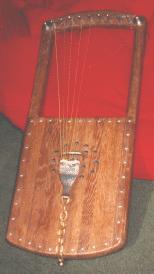John's music things
I can do this! I used not to be able to -- I'm one of the many people
who was once (well, lots of times) told they couldn't sing. But
eventually, instead of saying You can't sing -- shut up!,
someone said You can't sing -- would you like me to teach
you? and so I learnt.
So if you're one of those people who'd like to sing but have been
told they can't -- take heart from my story! I'm starting to write a
simple InterNet Singing Lesson.
Oh yes, which part do I sing? Well on a good day, using a bit of
falsetto, I can get up to the top of the bass range.
Medi&ae;val singing
Medi&ae;val singing is thought to have been done in a more nasal
voice than modern western singing; perhaps something like the song of
some modern arabic countries. My interest in medi&ae;val song ties in
with my interest in languages; it explains, for example, why I know
Occitan.
Here is a song in early English, or perhaps Anglo-Saxon: the famous
``Prisoner's song'':
Ar ne kuþe ich sorghe non
Nu ich mot manen min mon
Karful wel sore ich syche
Geltles þolye ich muchele schame
Help God for þin swete name
Kinge of hevene ryche.
Iesu Christ soþ God soþ Man
Louerd þu riu upon me
Of prisun þar ich in am
Bring me ut and makye fre.
Ich and mine feren sume
God wot ich ne lyghe nocht
For oþre habeþ misnome
Ben in þis prisun ybrocht.
Almicti þat wel lictli
Of bale is hale and bote
Hevene King of þis woning
Ut us bringe mote.
Foryhef hem þe wykke men
God yhef it is þi wille
For whos gelt we beþ ypelt
In þos prisun hille.
Maiden þat bar þe hevene king
Besech þi son þat swete þing
þat hy have of us rewsing
And bring us of þis woning
For his muchele milse.
He bring us ut of þis wo
And us tache werken so
In þos liu go wu'sit go
þat we moten ey and o
Haben þe eche blisce.
I got into this in my teens -- I keep up with it sporadically; I'm
likely not to be up to date with the latest in early music
(reconstruction ideas, etc)!
Here's a list of things I play:
- English Harp
- I made this from a kit by Widsith (now called the Harp Makers
Workshop, I think).
- Shawm
- Mine is actually a modern (or continuing) folk instrument, the
Breton Bombart. It is one of the loudest mouth-blown
instruments, exceeded by the Rauschpfeife (which is like a
wind-cap shawm) and the very obscure Schryari, which described as
being remarkable for being even louder than the Rauschpfeife;
it appears to be similar, but with a tapering bore.
- Bucine
- A very simple straight wooden trumpet (I made this from scratch).
It uses its immense end-correction to let you lip up and down so far
that you can get complete chromatic scales from what might be expected
to be a harmonic-scale (bugle-like) instrument, thus surprising people
who think they know about instruments. A similar Swedish instrument,
made from birch-bark, is called the Lyr.
- Crumhorn
- But then, how many people do you know who don't play the Crumhorn?
- Tin whistle
- In various varieties, including a rather nice French one called
an Irish Flute.
- Four-hole Ocarina.
- The Ocarina is apparently a Victorian English attempt to make
something that looked like they thought an ancient and primitive
Peruvian instrument should. Acoustically, it is a Helmholtz
Resonator, or so I am told.
- Bagpipe
- I have a `feadan' (practice chanter for the Great Pipes) and
`goose' (practice chanter with bag but no drones).
- Tuohitorvi
- Finnish folk cornet (I made this from scratch). Like the Serpent,
the note depends very much on the embouchure and so you can play a
up-going scale while fingering a down-going one, and vice versa!
- Lyre
-


I've made several lyres, from scratch, basing them roughly on the
reconstruction in the British Musuem of the one found in the Sutton
Hoo burial ship. Shown here are the largest and the smallest of
them. The large one is very resonant, to an extent that surprised
and pleased me... the side arms are hollow all the way along! The
tuning pins are zither pins... for much of the rest, I had to
improvise; the bridges are drawer handles, and the frogs are
picture hooks! However, it is a little large for playing
comfortably, at least for my hands.
The lyre, in this form, is plucked, with one hand coming up
from underneath through the large gap. Each string plays just
one note -- there are no frets, levers or stops. There are also
bowed lyres.
- Jew's harp
- A strange cross between percussion and wind instruments, not
actually requiring any wind but being controlled entirely by
embouchure. Some experts can play these in two-part harmony,
playing one note under the tongue and one note over it.
- Tromba Marina (I made this from scratch).
- A bowed instrument played entirely on the harmonics.
- Recorder
- Embarrassingly, I've forgotten the fingering for this! We learnt
them at school, of course.
Links


![[John's home]](../home.png)